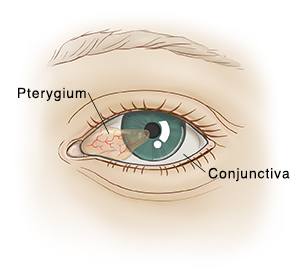Understanding a Pterygium

What is the conjunctiva?
The conjunctiva is the thin layer that lines the inside of your eyelids and the surface of your eye. In some cases part of this conjunctiva starts to grow abnormally. This growth most often starts on the white part of the eye that is closer to the nose. It can also begin on the other side of the eye. From there, the tissue can spread and cover the cornea. The cornea is the clear cap on the front part of your eye in front of the opening of your eye (pupil) and colored iris.
How a pterygium grows
A pterygium is not a type of cancer. It will not spread to other parts of your body. If you have a pterygium, it may stop growing at some point. Or it may continue to grow throughout your lifetime. It may grow over a period of months to years and then stop for a while. If it grows and covers your cornea, it is more likely to cause eyesight problems.
What causes a pterygium?
Scientists aren’t sure what causesa pterygium to occur. Eye exposure to ultraviolet light may be a cause. Having certain genes may lead to pterygia in some people. Spending a lot of time in the sun or not wearing sunglasses may increase your risks for a pterygium. If someone in your family has a pterygium, you may be more likely to have one.
Symptoms of a pterygium
In most cases, a pterygium is a wedge-shaped growth. Some people may notice their pterygium only after the growth has covered a large part of their cornea and blocked some eyesight. The pterygium might be white, pink, or red. Symptoms are often mild. Many people don’t have any symptoms, especially if the pterygium is still small. Some symptoms can include:
Eye irritation
Eye dryness
Eye redness
Visual blurriness, if the pterygium gets close to the middle of your cornea
Restricted eye movement (rare)
Diagnosing a pterygium
Your healthcare provider will ask about your health history and give you a physical exam. This may include a detailed eye exam, especially if you have eyesight symptoms. Your healthcare provider may refer you to an eye doctor (ophthalmologist).
Your eye doctor will look closely at the growth to make sure it is not another eye condition. In some cases the doctor may take a small sample (biopsy) of the pterygium. The sample is checked for cancer. Most people will not need a biopsy.